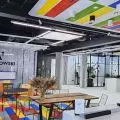form results from resources: circular architecture by {tag:pracownie}.
In 2007, architecture studio RXN decided to expand into GXN, a research studio that develops design solutions for sustainable architecture. Recently, the results of their work have resulted in a place where many would like to work.
The office space facilitates interaction between employees
Photo: Claus Peuckert | © GXN
(text compiled from studio materials)
The new office space created for Tscherning is an example of design thinking that negotiates between people and materials. The GXN team was tasked with renovating the organization's headquarters in a way that reflects Tscherning's identity as a family-owned construction demolition company. The old warehouse was transformed into a cafeteria, meeting rooms and offices. The renovated interior is an energetic, informal and modern workplace, while conveying the organization's ambitious goal of being the most environmentally friendly demolition company in Denmark. Tscherninghuset stimulates the senses and improves employee well-being and fosters social interaction. The project is exploring the potential of using building materials exclusively from elements recovered from dem olition sites in Denmark, such as bricks from a former prison or stairs from a public school. GXN has also developed a strategy for interior designers that adapts to the resulting changes brought about by the use of secondary materials.
"Each element used has a history that can be traced back to a demolition site, a specific building or a specific process. In this project, the aesthetics and visual language arise from a circular approach, rather than being predetermined as a starting point." - My Lunsjö, Behavioral Design Specialist and Partner at GXN.
The architects treated the designed office as a route full of different experiences
Photo: Claus Peuckert | © GXN
closed loop economy
Designing for a circular economy means adopting a specific value system. Design assumptions should include and value not only the object of architecture, but also what it is made of and the impact it has on its users. Increasing the value of often undervalued demolition materials requires the development of a flexible framework that helps navigate the unpredictability of the design process through guidelines for place-making and material use. Sweco 'slife-cycle assessment (LCA) shows a carbon impact of 2.57 kgCO2 equivalent per square meter per year, one of thelowest in Denmark, and proves the important role of material reuse in decarbonizing new construction. A similar building with new materials would have an environmental impact of 6.11 kg ofCO2 equivalent per square meter per year. The project achieves a 58% reduction in environmental impact over 50 years, saving a total of 318.6 tons ofCO2 equivalent. It is worth noting that these values do not take into account operation. The building materials used in the project are set at 0 kg ofCO2 equivalent per square meter per year according to the calculation method of the Danish Building Code.
Circular circulation
© GXN
diversity is a matter of choice
By observing the company and working closely with its director, Søren Tscherning, the GXN team was able to understand the different types of users - from demolition workers to administrative staff and board members - and their individual needs to feel welcome and thrive in the work environment. In view of this, the new office seems familiar while being stimulating, as the diversity of the space results in a number of views that depend on the angle of view, encouraging dynamic discovery of what is not obvious from the start.
The designers treated the office as a route through different zones, each with its own identity, character and atmosphere. This translated into a space that provides different experiences, fuels curiosity, invites exploration and offers surprises to its users. The sensory richness created by using different materials and scales both enhances the pleasure of experiencing the architecture and promotes the well-being of those who are there on a daily basis. Rooms of different scales display elements and materials in a showroom-like manner, yet remain practical. The design resulted in a harmonious and non-obvious place with character. The color scheme matched muted and neutral colors with the materials used, such as wood, steel and live plants.
Zones into which the space is divided available to employees
© GXN
"Natural recycled materials, thanks to their irregularity and patina of time, can influence the positive response of users' bodies and promote their well-being. It's about what users touch, what surfaces they walk on, the smell of different materials and the ability to feel different climate zones (indoor, outdoor, greenhouse/winter garden)." - My Lunsjö, Behavioral Design Specialist and Associate at GXN.
Color palette
© GXN
biophilia and secondary materials
Biophilia
© GXN
Biophiliais the innate emotional connection between humans and other living organisms. As a factor with proven effects on our physical condition and mental health, it has become a key criterion in integrating nature into interiors where people can thrive. The approach of the Tscherninghuset architects takes into account both direct and indirect contact with nature. The design works with biophilic elements, such as greenery, producing a sensory-rich environment. These biophilic principles were key in creating an intuitively welcoming and cozy atmosphere for employees.














































